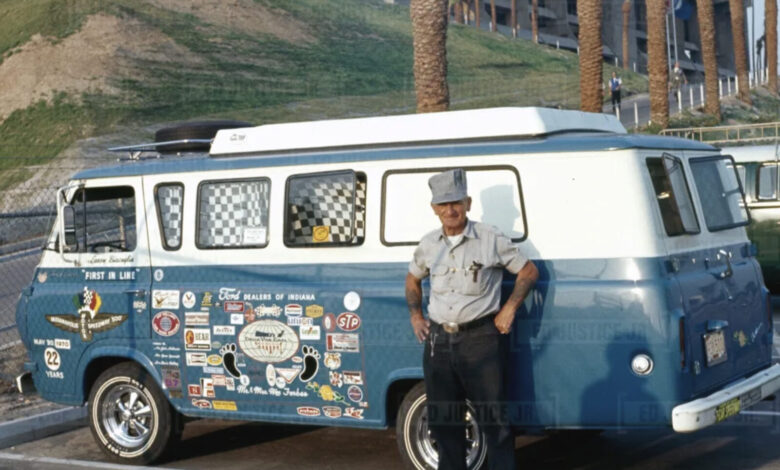“30 DAYS IN MAY!”

Many years ago, the Indianapolis Motor Speedway (IMS) had a slogan that symbolized the activities of the month of May in Indianapolis. That slogan was “30 days in May,” and people said it all the time.
Until 1974, the Indy 500 was run on the Memorial Day holiday, May 30th, regardless of the day of the week. The Motor Speedway opened for practice on May 1st and every day, racing teams arrived to begin preparation for their attempt to win the Indy 500. There was hype! There was fanfare! There was excitement because those were the days when the speed of the race cars had not maxed out. A speed of one-hundred-fifty mph had not been reached. Each day, drivers took the track in hopes of getting enough speed to be one of the fastest 33 on qualification day. Hundredths of a second faster was hailed as a great accomplishment.
So from May 1st to Race Day, May 30th, “thirty-days-in May,” everyone’s focus was on the IMS. Each day, the three local television stations, channels 6, 8, and 13, and The Indianapolis Star reported details of the activities of the day at the track. “Today at the Track,” and “Trackside 6,” were two of programs televised locally and broadcast at 6:00 pm and 11:30 pm every day. News wasn’t instant back then so I watched at both 6:00 and 11:30 to hear a synopsis of the day’s activities at the track. We learned who was fast in practice, their speed, and how close they were to breaking the 150 mph barrier. We heard about mishaps at the track—who spun out, who hit the wall, who was hurt, who was killed! In those days, drivers had none of the protections they have today so fatal accidents were inevitable. It was just part of racing.
Also back then, racing teams had chief mechanics who ran all the technical aspects of the team. Electronics, technology, and computers weren’t existent at that time and most cars were powered by 4-cylinder Offenhauser engines. They were temperamental so it was the chief mechanic’s job keep the car running and gain enough speed to qualify for the race. Many chief mechanics, like George Bignotti, became household names and shared the same celebrity as the drivers and car owners.
Every year, the first day of May was looked upon with great anticipation. For $5.00 fans could enter the track every day to watch teams and drivers during practice sessions. The hope was you might be there when Jim Hurtibise, Jim Rathman, or Roger Ward hit that elusive 150 mph mark. Lap speeds were not instantly available in those days. The devices used for determining speeds were like stopwatches, and it might take a minute to calculate the speed. During daily practice sessions your favorite driver might not take the track until late in the day when track temperatures were cooler. A cooler track meant better traction and faster speeds.
Four weekend days in May were set aside for “practice and qualification.” On two consecutive Saturdays and Sundays, each car and driver hoped to be one of the fastest 33 and qualify for the race. The weather in Indiana in May is iffy so it was inevitable that one of the weekends would be rained out or have lousy enough weather to be less than optimal for fast speeds. That left two days to qualify. The first day of qualifications was Pole Day. That means the fastest qualifier that day started on the inside of the first row, the best place to start the race and gain the early lead. The other 32 spots were determined in descending order of speed. Any car qualifying at a faster speed than the 33 already set would “bump” the slower car and take a place near the end of the starting grid.
On race day, fans had been lined up outside the main entrance for hours to pay the $5.00 general admission fee to drive their vehicle to their favorite parking spot inside the track. Access to the infield was restricted until 5:00 am on race day so for days, even weeks, in advance people would park their truck or camper outside the gate on Georgetown Rd., the western boundary of the IMS property, to be one of the first to get in. For 37 years, Larry Bisceglia, a mechanic from Yuma, Arizona, (pictured) made it his quest to be the first in line to enter the infield on race day. Every year, The Star had a picture and story of Bisceglia arriving at the main gate. Each year he had to arrive a little earlier to be sure to beat the competition. In 1958, Bisceglia was given a lifetime pass to the race by track owner Anton “Tony” Hulman. His last race was in 1987. He must have had a lot of free time because being first to arrive he had to live in his truck for all “30 days in May”—from the time he arrived until the race.
The 30th day in May was Race day. The Indianapolis 500 Mile Race, or the Greatest Spectacle in Racing, as it is known, happened on the Memorial Day holiday so pre-race ceremonies had a heavy emphasis on patriotism and honoring fallen veterans. The playing of The National Anthem, a prayer remembering those Americans who had died at war, TAPS, a 21-gun salute, the release of thousands of helium-filled balloons, and the penultimate singing of “Back Home Again in Indiana” all led to those famous words, “GENTLEMEN, START YOUR ENGINES! If you didn’t have a lump in your throat or a tear in your eye by then, you weren’t a true Hoosier.
The first time we went to the race, we were the guests of a company with whom my father had a business connection. We rode to and from the track on a Greyhound bus that had unimpeded access to the Paddock grandstand where we sat. Believe it or not, we dressed up. My wife bought a new dress just for the occasion. We sat across from the pits just north of the start-finish line and could see the entire front straightaway. Then Murphy’s law took over; it rained. Oh, well. We left because the race was postponed until the next day.
All other times we didn’t dress up. We tried to predict the unpredictable weather and dressed accordingly. We had rain gear and warm jackets, but with food and drink the priority, space for extra clothes and rain gear was limited.
We sat inside the track for the 1963 race. We never did that again. We sat on the back straightaway, which was a terrible place to sit—your peripheral visibility is very restricted, and the cars went by so fast we couldn’t read their numbers. Sitting on the outside the track one’s field of vision is much broader, but the cars still pass in a blur. Most of the time we sat at the end of the first turn in the Southwest Vista, an excellent place to sit.
Getting 300,000 people to the same spot all at once is a monumental effort, but the IMS and the town of Speedway know how to do it. Speedway residents are more than willing to let fans park in their front yards—for a fee, of course. We did that several years when we didn’t have a special parking pass. The weather in May being as it is, we got rained on, rained out, froze to death, and sunburned to blistering. Take your pick; we had them all! We tried to be prepared for any weather, but one year, when it was cloudy and 55°, we were unprepared. In a moment of desperation, we cut head and arm holes in trash bags and wore them to stay warm. Several times rain and cold temperatures forced us to stay in our cars until the weather cleared or they postponed the race. Then we had to wait until the track dried out so the race could start. It takes asphalt a long time to dry out when it’s cloudy with 90% humidity.
The Race never disappointed, though. The start of the Indy 500 is one of the most spectacular scenes in sports. A mass of 33 race cars driving by at 180 mph (speeds were slower back then) took my breath away and made my heart race every time. It is the most exhilarating thing in sports I’ve experienced. Nothing compares. Depending on caution flags, accidents, pit stops, and the pace of the race, it could last 3-4 hours or more. There was action aplenty! Spins, passing, short pit stops, long pit stops, engine fires, and terrible crashes set the pace and length of the race. There was alway exciting action right in front of our seats even if we could see only part of the south end of the track.
We always packed lunch—sandwiches, chips, dill pickle slices, soft drinks, and brownies. Our coolers were always lighter at the end of the race than the beginning. We had the same seats every year so the people around us were the same every year. That is except for the four seats two rows in front of us that every year were filled by different people who always seemed to drink too much. Some occupants were obnoxious and belligerent; some were not. But by the end of the race, they were passed out and didn’t bother us.
Thirty days in May no longer exists except as a book about the 1971 Indy 500. This year, opening day for the Indy 500 is May 16th, with practice sessions each day until Saturday and Sunday, May 20th and 21st, the two days for qualifications. A day of practice and several special events occur on “Carb Day,” May 26, and the Race is run on Sunday, May 28. On May 12 is practice and qualifying for the Indy Grand Prix, a road race on the IMS road course. It is run on May 13th. A third race, the Indy Lights Freedom 100, was on carb day, but is cancelled this year. The 500 Festival Committee also sponsors the Indy 500 parade on May 27th and the Mini Marathon on May 6th, both very popular events. So really it’s “22 days in May,” not 30, but it’s a packed three weeks.
If you’ve never been in Indianapolis in the month of May, it’s something to add to your “bucket list.” In spite of uncertainty of the weather, It’s a three-week party that has something for everyone.
Addendum: A neighborhood friend and reader shared that as a kid he sold newspapers in the stands at the IMS on qualification days and race day. He said he could make a “fortune,” especially if there were a special edition. “A fortune” he defined as $20+ a day.




Can’t remember if I told you that I was a volunteer /paid Member of the USAC Timing and Scoring Div for the INDY 500. Did that for 15 years. Loved it !
Yes, you did! I remember it well.
As a kid, back in the late 50s, I used to make a fortune ($20+ per day) selling papers (The old Indpls Times) in the stands, on the 4 days of Qualifications, and on Race Day. I did this for several years. If you were the 1st kid in the stands, with an Extra Edition due to a crash or something, you could really rake it in!
Cool bit of information. I may add that to the blog.
Dr. G,
I love your memories and description. It is still a great experience. I’m looking forward to heading to the track this year.
Hope you and Mrs. Gilkison are both doing well. Hope to see you this fall or winter.
Thanks, Katherine. We hope to see you, too.